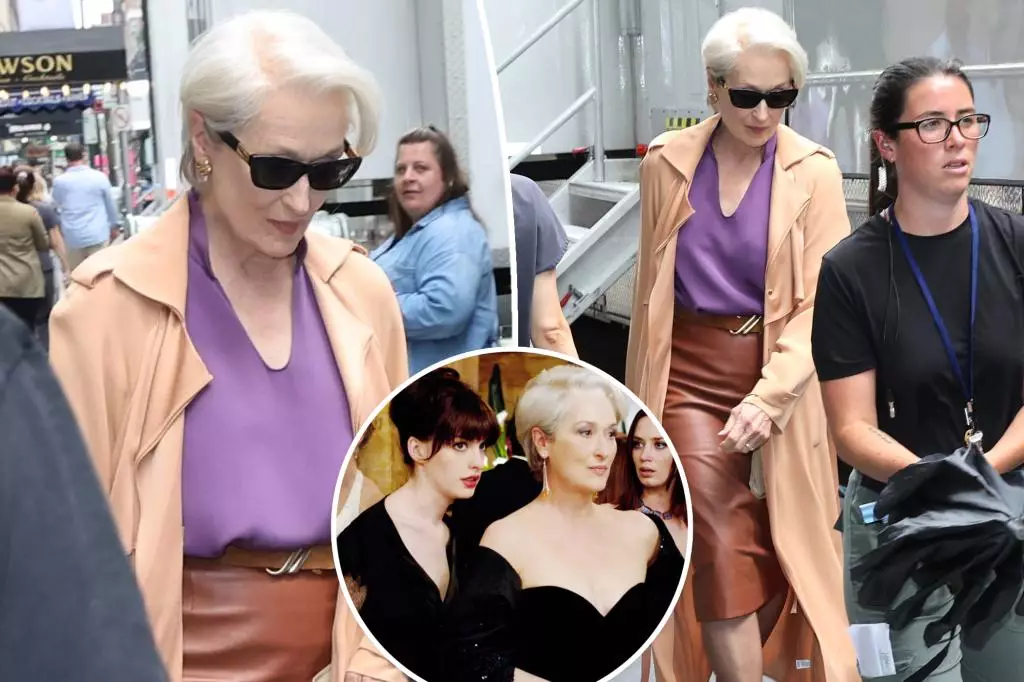The recent on-set sightings of Meryl Streep as the formidable Miranda Priestly signal more than just a sequel—they mark the revival of a cultural phenomenon that redefined the fashion and film industries. Streep’s portrayal of the sharp, icy editor-in-chief remains iconic, and her return hints at a narrative layered with contemporary relevance. The image of her in her signature long pixie cut, clad in a sleek tan trench, signals not just continuity but a reinvigoration of a character so deeply embedded in pop culture that her presence alone commands anticipation. This isn’t merely about nostalgia; it’s about examining how a character designed to symbolize the cold and ruthless business elite becomes a lens through which we assess progress and persistence in the creative world.
The choice of wardrobe is deliberately evocative—a calculated brushstroke meant to evoke the original’s aesthetic while weaving in modern sophistication. The image of Priestly with dark sunglasses, commanding presence, and impeccable style underscores her enduring authority, reminding us that even as the industry evolves, the archetype of the powerful, imperious boss remains alluring and relevant. The screenplay likely explores how her influence operates in an environment transformed by digital media, declining traditional print, and shifting cultural values.
The Cultural Significance and the Power of Nostalgia
The anticipation surrounding the sequel is fueled by an intricate blend of nostalgia and curiosity about the evolving narrative. The original film, a biting satire on the fashion world, became a blueprint for managing ambition, power, and personal compromise. Its characters—particularly Emily Blunt’s high-strung assistant and Anne Hathaway’s ambitious journalist—became archetypes that resonate even now. The new installment promises to delve into these characters’ trajectories, especially with Emily now positioned as a high-powered executive.
From a broader cultural perspective, revisiting this universe offers an astute commentary on the shifting landscape of media and authority. The sequel is expected to confront the decline of traditional magazines and the rise of digital influence, hinting at a narrative that is as much about industry transformation as it is about personal ambition and power struggles. Such a storyline invites viewers to reflect on the change in creative industries, the erosion of old guard dominance, and the entrenchment of new power structures—all under the guise of a glamorous narrative.
Furthermore, the casting of newcomers like Kenneth Branagh and Lucy Liu signals a diversification of perspectives—an acknowledgment that the issues of power and influence are global and multifaceted. Hathaway’s portrayal of Andy Sachs, with her eclectic fashion choices, bridges her character’s journey from the original to this new chapter, symbolizing growth and resilience.
Behind the Scene Dynamics and the Power of Cast and Crew
Meryl Streep’s candid reflection about her prior experience reveals a layer of self-awareness—a recognition that embodying such a complex character was both a challenge and a personal journey. Her admission of discomfort during filming highlights the intense dedication required to bring such a layered persona to life. It also sparks a conversation about the emotional toll that method acting and immersion can exert, especially when portraying characters that symbolize traits we often associate with power and coldness.
The addition of high-profile actors like B.J. Novak and Justin Theroux adds depth to the project, promising a multifaceted exploration of industry power plays. Their inclusion hints at a narrative direction that’s more nuanced, with characters that embody various facets of influence, ambition, and morality in today’s cutthroat cultural landscape.
Returning to the film’s core, it seems evident that this sequel isn’t simply about revisiting a beloved character; it’s an active commentary on the evolution of industries, societal values, and personal identity within the framework of glamour and ambition. As the release date approaches, expectations hinge on whether this new chapter will honor its roots or reinvent the story to confront the realities of the modern world.
This film’s success will ultimately depend on its ability to balance nostalgia with fresh insights, to make us reevaluate what power means in an era where image and influence are more fluid than ever. If executed with the same sharp wit and keen eye for cultural detail that made the original a classic, the sequel could stand not only as entertainment but as a statement about resilience, reinvention, and the enduring allure of commanding authority.

